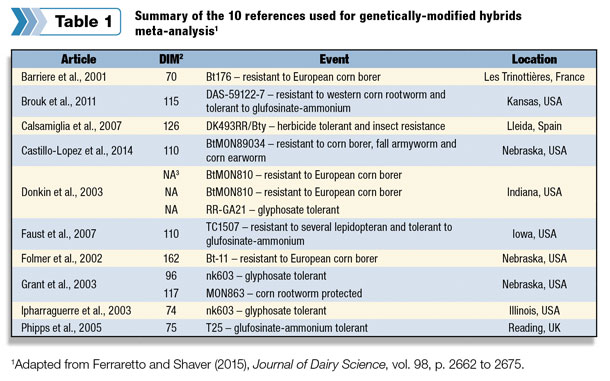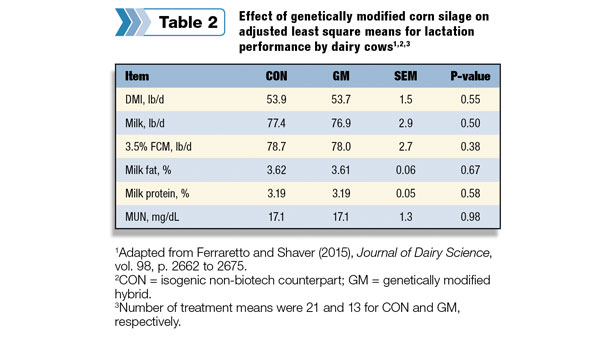High-quality corn silage contributes greatly to supplying the energy, starch and forage neutral detergent fiber needs of high-producing dairy cows, reducing purchased feed costs from expensive grain and byproduct supplements, and generating milk revenue for dairy producers.
Genetically modified (GM) corn hybrids have become common for corn silage production, and research has not suggested cause for concern about feeding corn silage produced from GM seed corn when the traits make agronomic and economic sense to the grower. This research will be reviewed in this article.
Biotech corn continues to become more prevalent for the production of not only grain but also corn silage, with the trend toward multiple or stacked traits for herbicide tolerance and pest resistance. These GM corn hybrids represented 91 percent of the 90.6 million acres of planted corn in the U.S. in 2014.
Examples of GM corn are the hybrids altered for insect resistance through the expression of proteins produced by Bacillus thuringiensis bacterium, commonly known as Bt-corn, which offer an alternative for corn growers against insect infestation.
Recent reviews have indicated that the use of GM corn enhanced yields and reduced exposure to environmental risks, thereby providing economic benefits for corn growers. Possibly, GM corn may also benefit dairy farmers that grow GM corn hybrids for silage production.
To evaluate the nutritive value of feeds, animal feeding experiments are needed. We compiled a dataset, comprised of 34 treatment means from 13 experiments reported in 10 peer-reviewed papers published in the Journal of Dairy Science or Journal of Animal Science (refer to Table 1), to evaluate the effects of corn silage derived from GM hybrids on lactation performance by dairy cows through a statistical meta-analysis.
 Experiments conducted in both Europe and the U.S. evaluated GM hybrids containing herbicide tolerance, insect resistance or both traits. All studies included in this dataset were with lactating dairy cows fed TMRs and compared a GM hybrid to its non-biotech counterpart.
Experiments conducted in both Europe and the U.S. evaluated GM hybrids containing herbicide tolerance, insect resistance or both traits. All studies included in this dataset were with lactating dairy cows fed TMRs and compared a GM hybrid to its non-biotech counterpart.
The hybrids were in two categories for the analysis: conventional (CON) and GM hybrids. Four trials compared a GM hybrid against two commercial hybrids in addition to the genetically similar non-biotech counterpart, and one trial compared CON versus GM at both early and late maturity in two trials.
Thus, there was a larger sample size for CON than GM hybrids (21 versus 13, respectively). Nutrient composition of the CON and GM corn silages were similar for dry matter, crude protein, lignin and ash, and averaged 37.1 percent, 8 percent, 2.6 percent and 4.8 percent, respectively.
Although trends for 1.3 percentage unit increases in acid and neutral detergent fiber (NDF) contents and a 1.3 percentage unit decrease in starch content for GM compared to CON were observed, these differences are minor.
Results from the statistical analysis of lactation performance data are presented in Table 2. There were no differences in dry matter intake (DMI), milk yield or milk composition for cows fed GM compared to CON corn silages.
 These data confirm that dairy producers and nutritionists should not be concerned about feeding whole-plant corn silage produced from GM corn once the traits make agronomic and economic sense to the grower.
These data confirm that dairy producers and nutritionists should not be concerned about feeding whole-plant corn silage produced from GM corn once the traits make agronomic and economic sense to the grower.
Further development of commercial GM corn hybrids with drought tolerance or specific nutritional quality traits may be warranted.
With conventional hybrids, minimal increases in the digestibility of NDF in vitro (ivNDFd; percent of NDF) were observed in a recent summary of the University of Wisconsin annual commercial corn silage hybrid agronomic performance trials conducted from 1996 through 2010.
Our meta-analysis also evaluated other specialty non-GMO corn hybrids for silage production. Reduced lignin content and corresponding increases in ivNDFd, DMI and lactation performance has consistently been reported for BMR (bm3) mutant corn hybrids.
However, despite the consistent response of greater ivNDFd by BMR hybrids over the years in University of Wisconsin performance trials and thereby greater milk-per-ton estimates, whole-plant DM yield per acre and starch content (1 to 7 percentage units lower) limited their milk-per-acre potential.
Recently, U.S. Dairy Forage Center researchers reported similar milk production responses for either altered lignin cross-linking through reduced-ferulate mutant lines or reduced lignin content through bm3 mutant lines compared to near-isogenic control lines of each type, with all lines harvested and fed as whole-plant corn silage.
These authors suggested that combining both mutations in the same corn line may allow for greater improvements in animal performance since the genes and modes of action (ferulate cross-linking versus lignin content) involved are different.
Use of GM technology could hasten the inclusion of this and other nutritional traits in corn for silage production. There have been reports on GM bm3 plants with reduced lignin and increased fiber digestibility, but this has not yet led to the availability of commercial GM bm3 hybrids.
An example of GM technology enhancing feed quality is the recent approval of reduced-lignin GM alfalfa by USDA-APHIS. Adoption of reduced-lignin GM alfalfa by growers may hasten the development of GM technology in corn hybrids to improve the nutritive value of corn silage.
Other areas with potential for improving the nutritive value of corn grain and silage for dairy cows with GM technology could include oil with increased oleic acid and reduced linoleic acid to minimize milkfat depression often encountered when high-corn-silage diets are fed, increased protein and lysine contents to reduce supplemental needs to meet cow requirements, and low vitreousness to increase starch digestibility and thereby lactation performance of dairy cows.
Although commercial GM corn hybrids specific for improving the nutritional quality and feeding value of corn silage are not available, in the future their availability could enhance progress for improving the digestibility of NDF and starch and also potentially help circumvent major nutritional limitations to the feeding of high-corn-silage diets to dairy cows. PD
Randy Shaver is with the University of Wisconsin – Extension Department of Dairy Science. He can be contacted by email.
References omitted due to space but are available upon request. Click here to email an editor.
PHOTO: Staff photo.
-
Luiz Ferraretto
- Department of Dairy Science
- University of Wisconsin – Madison
- Email Luiz Ferraretto






